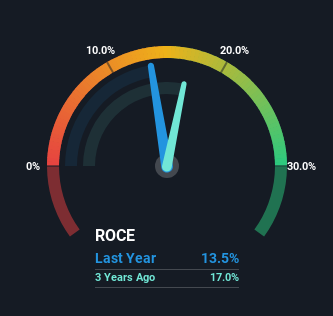Stock Analysis
- United States
- /
- Software
- /
- NYSE:ORCL
Oracle (NYSE:ORCL) Has More To Do To Multiply In Value Going Forward

If we want to find a potential multi-bagger, often there are underlying trends that can provide clues. Amongst other things, we'll want to see two things; firstly, a growing return on capital employed (ROCE) and secondly, an expansion in the company's amount of capital employed. Put simply, these types of businesses are compounding machines, meaning they are continually reinvesting their earnings at ever-higher rates of return. However, after investigating Oracle (NYSE:ORCL), we don't think it's current trends fit the mold of a multi-bagger.
What Is Return On Capital Employed (ROCE)?
If you haven't worked with ROCE before, it measures the 'return' (pre-tax profit) a company generates from capital employed in its business. The formula for this calculation on Oracle is:
Return on Capital Employed = Earnings Before Interest and Tax (EBIT) ÷ (Total Assets - Current Liabilities)
0.13 = US$15b ÷ (US$134b - US$24b) (Based on the trailing twelve months to November 2023).
So, Oracle has an ROCE of 13%. In absolute terms, that's a satisfactory return, but compared to the Software industry average of 7.6% it's much better.
View our latest analysis for Oracle

In the above chart we have measured Oracle's prior ROCE against its prior performance, but the future is arguably more important. If you'd like to see what analysts are forecasting going forward, you should check out our free report for Oracle.
So How Is Oracle's ROCE Trending?
Over the past five years, Oracle's ROCE and capital employed have both remained mostly flat. This tells us the company isn't reinvesting in itself, so it's plausible that it's past the growth phase. So unless we see a substantial change at Oracle in terms of ROCE and additional investments being made, we wouldn't hold our breath on it being a multi-bagger.
Our Take On Oracle's ROCE
In summary, Oracle isn't compounding its earnings but is generating stable returns on the same amount of capital employed. Investors must think there's better things to come because the stock has knocked it out of the park, delivering a 145% gain to shareholders who have held over the last five years. However, unless these underlying trends turn more positive, we wouldn't get our hopes up too high.
If you want to continue researching Oracle, you might be interested to know about the 1 warning sign that our analysis has discovered.
If you want to search for solid companies with great earnings, check out this free list of companies with good balance sheets and impressive returns on equity.
Valuation is complex, but we're helping make it simple.
Find out whether Oracle is potentially over or undervalued by checking out our comprehensive analysis, which includes fair value estimates, risks and warnings, dividends, insider transactions and financial health.
View the Free AnalysisHave feedback on this article? Concerned about the content? Get in touch with us directly. Alternatively, email editorial-team (at) simplywallst.com.
This article by Simply Wall St is general in nature. We provide commentary based on historical data and analyst forecasts only using an unbiased methodology and our articles are not intended to be financial advice. It does not constitute a recommendation to buy or sell any stock, and does not take account of your objectives, or your financial situation. We aim to bring you long-term focused analysis driven by fundamental data. Note that our analysis may not factor in the latest price-sensitive company announcements or qualitative material. Simply Wall St has no position in any stocks mentioned.
About NYSE:ORCL
Oracle
Oracle Corporation offers products and services that address enterprise information technology environments worldwide.
Good value with proven track record and pays a dividend.

